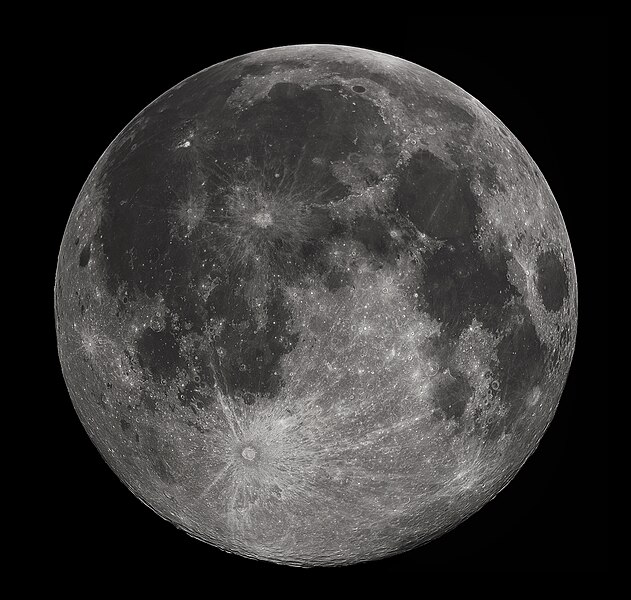Apollo 11 50th Anniversary: The Lunar Minerals

The MOOOOOOOOON!!! (image: Wikimedia)
50 years ago today, Apollo 11 accomplished the bold feat of landing on the Moon and not only did they walk on the Moon, they brought back some of it with them on their return for study. Some bits of lunar rock found their way to becoming thin sections, which you can view here, and occasionally get loaned out to researchers outside of NASA. I was lucky enough to handle and view some of these thin sections in my undergrad Igneous and Metamorphic Petrology class, as well as a thin section of a Martian meteorite (the closest I'll ever get to being on Mars). The lunar rocks have been well-studied by geologists over the years and Mindat.org has curated a list of minerals found on the moon, almost all of which are also found on Earth.
The Moon can, in a broad sense, been generalized into two types of igneous rocks: basalt and anorthosite. The bright, white-grey parts of the Moon are the anorthosite dominated areas. These are feldspar-rich rocks that formed gradually as magma cooled and the low-density feldspar minerals floated to the top of the magma becoming part of the Moon's crust (similar to Earth's continental crust). While the crust was cooling, several meteoric impacts released the higher-density basaltic magma to flood craters, leaving behind the dark grey basalt 'mares' that speck the surface of the Moon. The Apollo, Surveyor (US unmanned lander), and Luna (Soviet unmanned lander) missions primarily targeted these mares largely because they're broad flat areas that would likely be less rocky, making them easier to land on; especially at a time when we knew very little about the surface of the Moon.
Interestingly, the samples returned from the Apollo and Luna missions contained a few minerals that were previously unknown to science in these rocks. Here is a very brief introduction to the few minerals first discovered from lunar samples (and as such, the Moon is considered the type locality):
Armalcolite: A titanium mineral (Mg,Fe2+)Ti2O5) named after the Apollo 11 crew, Neil Armstrong, Buzz Aldrin, and Michael Collins, who brought back samples containing this mineral. This is a titanium mineral (image: Mindat, lunar sample)
Oxycalciobetafite: (Ca2(Ti,Nb)2O6O) First called yttrobetafite, this mineral was recently renamed in accordance with nomenclatorial rules, but has not been formally approved. This was first discovered from the Apollo 14 samples and has since been reported in terrestrial samples. (image: Mindat, sample from Germany)
Oxyuranobetafite: ((U,Ca)2(Ti,Nb)2O6O) Related to the previous mineral, this mineral was recently reported in lunar regolith samples returned from the unmanned Soviet lander Luna 24, but the name has not yet been formally approved. (image: Mindat, lunar sample)
Pyroxferroite: ((Fe,Mn,Ca)SiO3) This mineral, first found in Apollo 11 samples, has since been identified on Earth and in Martian meteorites. (image: Mindat, sample from Germany)
Tranquilityite: (Fe2+,Ca)8(Zr,Y)2Ti3(SiO4)O12) Named after the site of the Apollo 11 landing, Mare Tranquillitatis (Sea of Tranquility). This mineral has just recently been discovered on Earth in 2011 for the first time.
Yoshiokaite: (Ca,Na)[Al(Al,Si)O4] This feldspathoid mineral, found in Apollo 14 samples, was named after mineralogist, Takashi Yoshioka, who synthesized this mineral in the laboratory.

Thin section of a basalt sample from Apollo 11 (predominately plagioclase and augite) (image: VirtualMicroscope)






Comments
Post a Comment